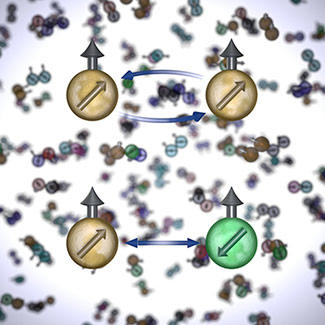JILA Team Finds First Direct Evidence of 'Spin Symmetry' In Atoms

Illustration of symmetry in the magnetic properties—or nuclear spins—of strontium atoms. JILA researchers observed that if two atoms have the same nuclear spin state (top), they interact weakly, and the interaction strength does not depend on which of the 10 possible nuclear spin states are involved. If the atoms have different nuclear spin states (bottom), they interact much more strongly, and, again, always with the same strength.
Just as diamonds with perfect symmetry may be unusually brilliant jewels, the quantum world has a symmetrical splendor of high scientific value.
Confirming this exotic quantum physics theory, JILA physicists led by theorist Ana Maria Rey and experimentalist Jun Ye have observed the first direct evidence of symmetry in the magnetic properties—or nuclear "spins"—of atoms. The advance could spin off practical benefits such as the ability to simulate and better understand exotic materials exhibiting phenomena such as superconductivity (electrical flow without resistance) and colossal magneto-resistance (drastic change in electrical flow in the presence of a magnetic field).
The JILA discovery, described in Science Express,* was made possible by the ultra-stable laser used to measure properties of the world's most precise and stable atomic clock.** JILA is jointly operated by the National Institute of Standards and Technology (NIST) and the University of Colorado Boulder.
"Spin symmetry has a very strong impact on materials science, as it can give rise to unexpected behaviors in quantum matter," JILA/NIST Fellow Jun Ye says. "Because our clock is this good—really it's the laser that's this good—we can probe this interaction and its underlying symmetry, which is at a very small energy scale."
The global quest to document quantum symmetry looks at whether key properties remain the same despite various exchanges, rotations or reflections. For example, matter and antimatter demonstrate fundamental symmetry: Antimatter behaves in many respects like normal matter despite having the charges of positrons and electrons reversed.
To detect spin symmetry, JILA researchers used an atomic clock made of 600 to 3,000 strontium atoms trapped by laser light. Strontium atoms have 10 possible nuclear spin configurations (also referred to as angular momentum), which influences magnetic behavior. In a collection of clock atoms there is a random distribution of all 10 states.
The researchers analyzed how atom interactions—their collisions—at the two electronic energy levels used as the clock "ticks" were affected by the spin state of the atoms' nuclei. In most atoms, the electronic and nuclear spin states are coupled, so atom collisions depend on both electronic and nuclear states. But in strontium, the JILA team predicted and confirmed that this coupling vanishes, giving rise to collisions that are independent of nuclear spin states.
In the clock, all the atoms tend to be in identical electronic states. Using lasers and magnetic fields to manipulate the nuclear spins, the JILA researchers observed that, when two atoms have different nuclear spin states, no matter which of the 10 states they have, they will interact (collide) with the same strength. However, when two atoms have the same nuclear spin state, regardless of what that state is, they will interact much more weakly.
"Spin symmetry here means atom interactions, at their most basic level, are independent of their nuclear spin states," Ye explains. "However, the intriguing part is that while the nuclear spin does not participate directly in the electronic-mediated interaction process, it still controls how atoms approach each other physically. This means that, by controlling the nuclear spins of two atoms to be the same or different, we can control interactions, or collisions."
The new research adds to understanding of atom collisions in atomic clocks documented in previous JILA studies.*** Further research is planned to engineer specific spin conditions to explore novel quantum dynamics of a large collection of atoms.
JILA theorist Ana Maria Rey made key predictions and calculations for the study. Theorists at the University of Innsbruck in Austria and the University of Delaware also contributed. Funding was provided by NIST, the National Science Foundation, the Air Force Office of Scientific Research, and the Defense Advanced Research Projects Agency.
*X. Zhang, M. Bishof, S.L. Bromley, C.V. Kraus, M.S. Safronova, P. Zoller, A.M. Rey, J. Ye. Spectroscopic observation of SU(N)-symmetric interactions in Sr orbital magnetism. Science Express. Published online Aug. 21, 2104.
**See Jan. 22, 2014, Tech Beat article, "JILA Strontium Atomic Clock Sets New Records in Both Precision and Stability."
***See 2011 NIST news release "Quantum Quirk: JILA Scientists Pack Atoms Together to Prevent Collisions in Atomic Clock" and 2009 NIST news release "JILA/NIST Scientists Get a Grip on Colliding Fermions to Enhance Atomic Clock Accuracy."

